Wildflower Resolutions
Open, sunny roadsides are prime locations for wildflowers. Learn how you can help create native habitat corridors for pollinators by helping to protect roadsides.
What is a Wildflower Resolution?
In 2009, a model county resolution was developed by Florida Wildflower Foundation members Eleanor Dietrich and Jeff Caster. The resolution, which recognizes the historical, environmental and cultural significance of Florida wildflowers, is a pledge to conserve wildflowers through such management practices as reduced mowing.
Wakulla County enacted the first resolution, followed by Gadsden, Leon, Lake, Marion, Brevard and Volusia counties. Now, 37 counties and three municipalities have wildflower resolutions.
Scroll down to find your district and view your county’s or city’s resolution. If your county or city does not have a resolution, our “How to Get Started” guide below provides step-by-step instructions on facilitating the adoption process.
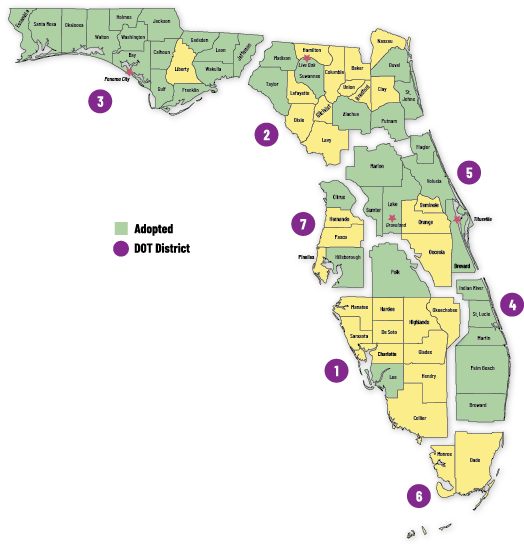
How to Get Started
- Select your district tab below. Counties that are green on the district map have adopted wildflower resolutions. If your county is green, click on the county’s name below the map to see how the resolution was adopted there. Contact those who led the effort to learn more.
- Team with a resident or organization that has ties with a county commissioner who supports environmental issues. If possible, organize a group effort by asking for help from Florida Wildflower Foundation members and local FNPS chapters, as well as from Audubon and Sierra Club chapters, garden clubs, civic organizations, and homeowners associations. Ask them for letters of support.
- After getting a commissioner’s support, work with the county public works staff to get their backing. Ask their advice about the best way to proceed, including the resolution’s final wording, scheduling a presentation to the county or city commission, and securing the commission’s vote.
- Download the model county resolution.
- Work with the county public works department to identify county, state and federal roads with showy stands of wildflowers. Ask your county’s roadside maintenance supervisor and your county’s FDOT maintenance representatives (state, federal roads) for advice about altering mowing practices to allow wildflowers to flourish naturally. Agree on a management plan for each road that includes the mowing extent, width and frequency. Put this in writing from the county public works department and submit it to the appropriate FDOT maintenance representative.
- Develop a follow-up plan. The adoption of a county wildflower resolution is only the first step in conserving roadside wildflowers. Organize periodic followups with county staff and issue reports on efforts. Develop a plan that includes publicity (newspapers, blogs), distribution of photos and educational materials, and site monitoring.
- How to Request a Wildflower Area
- Economic Impact of Ecosystem Services Provided by Ecologically Sustainable Roadside Right of Way Vegetation Management Practices — The dollar value of ecosystem services provided by roadside vegetation in Florida.
- Madison County Energy Conservation Study 2012-2013 Survey of Roadside Vegetation
- Safety Effects of Reduced Mowing
- Best practices: Establishing and maintaining roadside plantings (FDOT) (Dec 2008) — A scientific look at how selected native plant species can persist and flourish on Florida’s roadsides.
- Economic and Ecological Benefits of Roadside Native Wildflower Plantings— Select study findings on the benefits of native roadside plantings in the U.S.
- Ecosystem and Vegetation Management website – U.S. Department of Transportation
- Click here for more highway habitat research, and use the search terms “vegetation,” “habitat” or “wildflower.
- Evaluating the Importance of Roadside Habitat for Native Insect Pollinators
- Survey of Key Monarch Habitat Areas Along Roadways in Central and North Florida
- Creating Economically and Ecologically Sustainable Pollinator Habitat: A District 2 Demonstration Research Project
- Roadside Best Management Practices that Benefit Pollinators – U.S. Department of Transportation
- Pollinators and Roadsides: Best Management Practices for Managers and Decision Makers — U.S. Department of Transportation
- Evaluating the Suitability of Roadway Corridors for Use by Monarch Butterflies — National Academies of Science, Engineering and Medicine
District 1
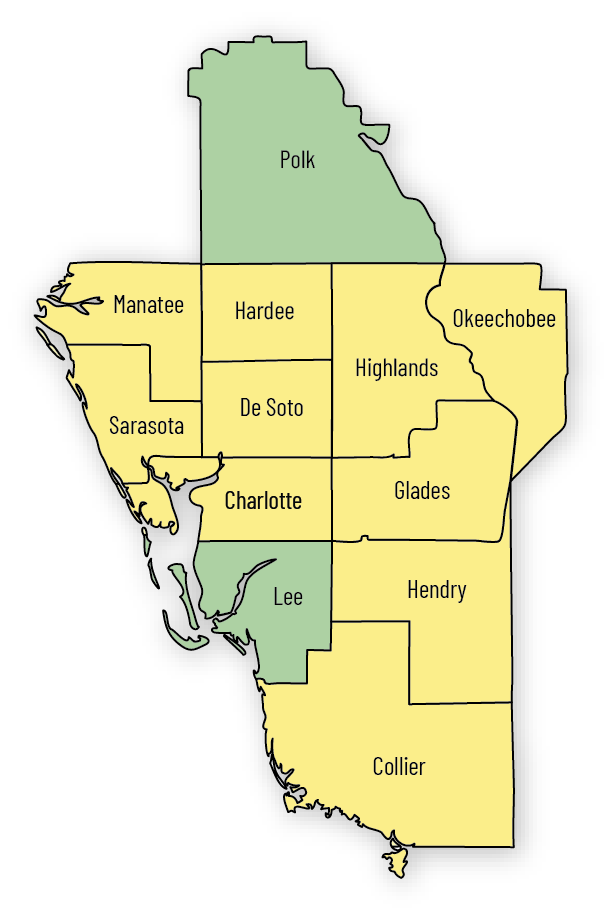
Click on the county name to view contacts and a copy of the resolution.
John Sibley of the Lee County Roadway Landscape advisory board and previous owner of All Native Garden Center, contacted Pat Moore and Joe Sulak, who direct the action of that board on behalf of the county. They collaborated on the resolution’s language then presented it to Holly Schwartz, assistant county manager. She submitted it to the county commission. Commissioner Ray Judah agreed to present the resolution to the board, which voted unanimously to pass it on March 29, 2011. The resolution instructs County staff to partner with the Florida Wildflower Foundation, Florida Dept of Transportation and adjoining property owners to plan and implement roadside management practices to promote wildflowers. Joaquin Herrera has taken over for John Sibley at All Native Garden Center.
See a copy of the resolution.
District 2
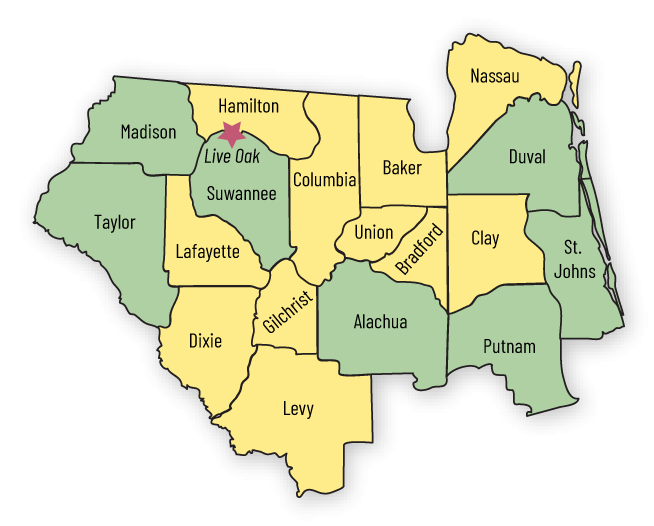
Click on the county name to view contacts and a copy of the resolution.
See a copy of the resolution.
Barbara Jackson of the Florida Native Plant Society, Ixia Chapter, asked Mayor John Peyton’s policy director to review the resolution for presentation to the Jacksonville City Council. After the review, the resolution was placed on the council agenda and adopted on May 12, 2011.
See a copy of the resolution.
After speaking with Florida Wildflower Foundation grant administrator Jeff Norcini, Suwannee County Conservation District Resource Consultant Michael Brown asked Adam Prins, Live Oak City Councilman, to present a resolution to plant wildflowers within the city limits. It was adopted by the city on April 10, 2012. Adam and Michael also helped get local community groups involved.
See a copy of the resolution.
See a copy of the resolution.
Then-FWF Executive Director Lisa Roberts gave a presentation about wildflowers and the resolution at a St. Johns River to the Sea Loop meeting. A few weeks later, County Manager Don Jacobovitz, who attended the Loop meeting, presented the resolution to the Putnam County Commission, which voted unanimously to adopt it.
See a copy of the resolution.
St. Johns County Commissioner Cyndi Stevenson worked with the St. Johns County Public Works Department in coming up with low maintenance groundcover for county rights-of-way. After learning of the Florida Wildflower Foundation’s La Florida Grant Program, Commissioner Stevenson again called on the Public Works Department to initiate applying for the grant. The Wildflower Resolution was adopted on May 3, 2011.
See a copy of the resolution.
FWF North Florida Wildflower Alliance Liaison, Geena Hill, gave a presentation in 2022 about the importance of roadside wildflowers to the FNPS Sparkleberry Chapter. Following that meeting, local activist Ellie Meyers presented to the Suwannee Board of County Commissioners to pass a wildflower resolution in Suwannee County.
See a copy of the resolution.
After receiving a copy of the model wildflower resolution and a press release from Lake County, Perry Garden Club president Vivian Sheffield asked for a volunteer to look into getting a wildflower resolution adopted in Taylor County. Volunteer Debbie Ross contacted Florida Wildflower Foundation Executive Director Lisa Roberts for guidance. This lead to a meeting with Cindy Dunkle, assistant maintenance engineer at FDOT’s Perry office, to learn about Florida’s roadway wildflower program. In March, Cindy gave a presentation to Taylor County Commissioners to explain the state wildflower program. The wildflower resolution also was submitted for approval. Commissioners verbally agreed to adopt the resolution, but wanted garden club members to identify a specific site for planting before signing it. After meeting with County Administrator Jack Brown, a planting site was identified and presented to commissioners. The resolution was signed on May 2, 2011.
See a copy of the resolution.
District 3
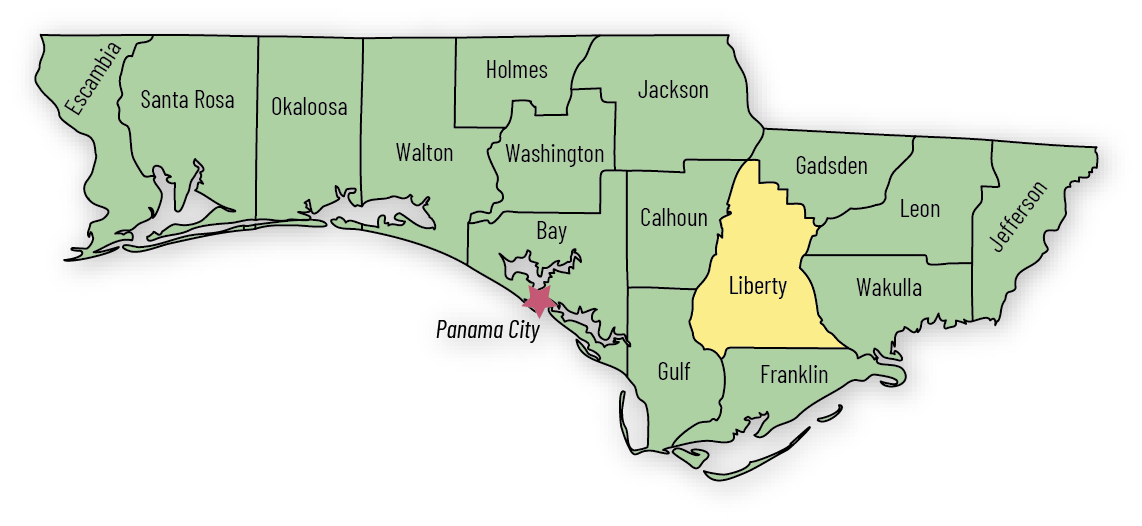
Click on the county name to view contacts and a copy of the resolution.
See a copy of the resolution.
In January of 2014, representatives of the Calhoun County Chamber of Commerce attended a workshop coordinated by the Florida Department of Transportation and the Florida Wildflower Foundation. The event previewed DOT’s new Wildflower Program procedure and shared information about how to develop and nurture wildflowers in your community.
Calhoun County is fortunate to be home to many species of beautiful native wildflowers The Chamber worked with RiverWay South Apalachicola-Choctawhatchee and the Florida Wildflower Foundation to develop a Wildflower Resolution. The resolution was presented to County Commissioners during National Wildflower Week. It passed unanimously on May 6, 2014.
See a copy of the resolution.
See a copy of the resolution.
In the spring of 2008, after the Big Bend Scenic Byway had been designated, Franklin County resident Lesley Cox suggested Franklin County adopt a right-of-way mowing regime to benefit wildflowers. In summer 2009, Wakulla County approved a FDOT pilot project to preserve native wildflowers. Since both of these counties are part of the Scenic Byway, it seemed a perfect fit to extend the wildflower experience into Franklin County. The proposed resolution was first presented in 2011, but was tabled. On March 6, 2012, the Franklin County Board of Commissioners passed the wildflower resolution.
See a copy of the resolution.
A Gadsden county commissioner happened to attend the Wakulla County Commission meeting at which a roadside wildflower policy was enacted. Afterward, he asked FDOT Landscape Architect Jeff Caster to write a resolution and present it to Gadsden’s commission. Jeff enlisted the help of Eleanor Dietrich to draft the document. It was adopted unanimously by Gadsden on Dec. 15, 2009.
See a copy of the resolution.
Local garden club members strongly supported having a wildflower resolution and contacted county commissioners to urge them to adopt one. Gulf County passed its wildflower resolution on April 25, 2017.
See a copy of the resolution.
In 2014, Bonifay Garden Club member DiAnn Shores asked the Holmes County Board of Commissioners to adopt a wildflower resolution. Dustie Moss, FDOT District 3 wildflower coordinator, and Eleanor Dietrich, liaison to FDOT for the Florida Wildflower Foundation, also addressed commissioners. After a brief discussion, commissioners passed the resolution unanimously.
See a copy of the resolution.
Jackson County has a number of groups supporting roadside wildflowers. A joint meeting with county staff in November 2016 quickly resulted in a wildflower resolution being passed on Nov. 15, 2016. The Jackson County TDC has taken the lead for getting Wildflower Areas on both county- and state-maintained roads. An inventory of possible sites was conducted in the spring, when wildflowers were blooming, resulting in a long list of potential roadsides.
See a copy of the resolution.
Members of the Jefferson County Tourist Development Council, County Commissioner Betsy Barfield and local wildflower enthusiast Paul Michael met with Pam Portwood and Diane Delaney of the Florida Wildflower Foundation’s Panhandle Wildflower Alliance on June 12, 2012. The group eagerly agreed to join Franklin, Wakulla, Liberty, Leon and Gadsden counties to increase the presence of wildflowers in Jefferson County and surrounding areas. The Jefferson County Board of County Commissioners unanimously passed the Wildflower Resolution on July 5, 2012.
See a copy of the resolution.
After learning of Wakulla County’s wildflower resolution, Eleanor Dietrich contacted a Leon County commissioner. Meanwhile, the Florida Native Plant Society Magnolia Chapter, Tallahassee, agreed to be the project’s community support group. Eleanor and FDOT Landscape Architect Jeff Caster met with county staff, after which Jeff made a presentation to the commission. The commission adopted the resolution on Jan. 19, 2010.
See a copy of the resolution.
In April 2009, entomologist Dr. Marc Minno and MaryAnn Friedman, an Okaloosa County resident, discovered Frosted Elfin caterpillars on sundial lupine (Lupinus perennis) along State Road 189 in Baker in the Blackwater River State Forest. In March of 2012, the Florida Department of Transportation agreed to accept a citizen request to change the mowing schedule along this state road to protect the imperiled butterfly and reduce impact on the sundial lupine the butterfly requires. This area has been monitored annually, and active cooperation with DOT and Forestry continues.
In 2016, Friedman requested that the Okaloosa Board of County Commissioners consider a Wildflower Resolution for the county. The board unanimously approved and the resolution was signed on April 5, 2016.
See a copy of the resolution.
The Wildflower Resolution was adopted in Feb 2017.
Contact: Suzanne Spencer
850-572-0791
spencersuze@gmail.com
Santa Rosa County’s Board of County Commissioners passed a wildflower resolution in July 2016. Santa Rosa County is home to the largest community of pitcherplants in the state. Four of the five county roads and two of the state roads have significant numbers of the state-listed endangered Whitetop pitcherplants (Sarracenia leucophylla) present on the roadsides, which are easily seen from the roadways. Upon closer inspection, the Yellow pitcherplant (S. flava) and the state-listed threatened Parrot pitcherplant (S. psittacina) can also be found growing in the wet ditches of two of the county roads. Two other state-listed threatened wildflower species have become visible in good numbers, thanks to reduced mowing — Pine lily (Lilium catesbaei) and Rose pogonia (Pogonia ophioglossoides). A visit to Santa Rosa County during the spring and fall wildflower seasons will reveal a wide variety and large populations of many beautiful native wildflowers species.
In 2019, Suzanne was named the Florida Wildflower Foundation Volunteer of the Year for her efforts.
See a copy of the resolution.
Wakulla was the first Florida county to make roadside wildflower management a priority. After meetings with the county public works director, county staff and FDOT maintenance engineers, FDOT Landscape Architect Jeff Caster was asked to make a presentation to the county commission. Immediately after his presentation on July 21, 2009, the commission voted unanimously to make roadside wildflower conservation a county policy.
In November 2011, the Walton Board of County Commissioners (BOCC) adopted a native wildflower resolution submitted through the Choctawhatchee Basin Alliance and accepted a $300 donation for seeds and flowers from the Friends of Scenic 30-A. As the resolution states, the enjoyment of native wildflowers will enhance the experience for residents, businesses and tourists alike and will have the added benefit of reducing costs from the Public Works budget by reducing the frequency and extent of roadside mowing. Once the flowers grow, the right of way will need to be mowed only once a year as the flowers will reseed themselves.
In 2020, a request was made to the BOCC to expand modified mowing on county roadsides. They agreed to implement a pilot project on a 1.2-mile stretch of CR 192
See a copy of the resolution.
On Jan. 28, 2014, several Chipley Garden Club members attended a meeting of the Florida Wildflower Foundation’s Panhandle Wildflower Alliance (PWA) in Tallahassee, during which FDOT introduced an updated Wildflower Program procedure. By March, the program’s information had been shared with Washington County Master Gardeners and garden clubs in Wausau, Vernon and Chipley. Kathy Foster, Foster Folly News, contacted the Washington County Commission and asked to present a county wildflower resolution. Glenda Wilson, Chipley Garden Club vice president, asked Eleanor Dietrich, liaison to FDOT for the Florida Wildflower Foundation, and FDOT District 3 wildflower coordinator Dustie Moss to present a short program to commissioners on May 28. The Washington resolution passed unanimously after the presentation.
See a copy of the resolution.
District 4
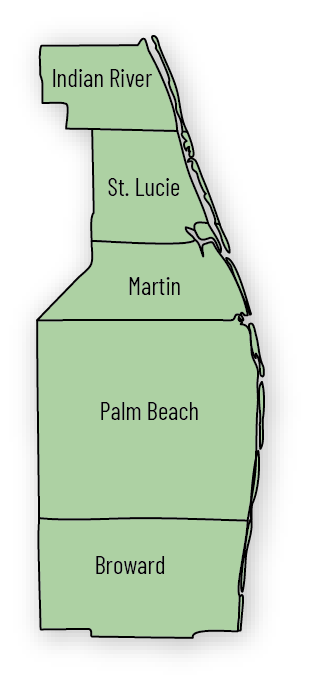
Click on the county name to view contacts and a copy of the resolution.
The Broward County Board of County Commissioners adopted a Wildflower Resolution on May 8, 2012. The resolution was sponsored by Vice Mayor Kristin Jacobs, a champion of environmental programs such as NatureScape Broward, which promotes the use of native plants to conserve water, protect water quality and create wildlife habitat. Increasing the visibility of native wildflowers in Broward County is consistent with the vision of NatureScape Broward and goals of many individuals, businesses, schools and community-based organizations.
See a copy of the resolution.
See a copy of the resolution.
On behalf of The Garden Club of Stuart, member Ann McCormick spoke with Martin County Commissioner Sara Heard about the resolution and the La Florida, “Land of Flowers” Community Planting Grants program. Using the model resolution, Ms. Heard’s staff readied the resolution for the March 13, 2012, commission meeting. During the meeting, Ms. McCormick told the commission about the grant program and wildflowers. She also gave examples of plantings other counties have done. The commission then voted unanimously to adopt the resolution.
See a copy of the resolution.
Recognizing the importance of wildflowers to the environment, Lisa Ferrano, a member of the Wellington Garden Club, requested the Palm Beach County Commission adopt a wildflower resolution. She e-mailed several commissioners and attached sample resolutions and links to the Florida Wildflower Foundation’s website. The initial response was negative, but after many e-mails and calls to county staff explaining the value of having a wildflower resolution, the commission unanimously passed a resolution on Sept. 11, 2012.
The members of the St Lucie County Chapter of the Florida Master Naturalists, with guidance from the UF/IFAS St Lucie County Cooperative Extension, drafted the Wildflower Resolution in St Lucie County. This resolution was reviewed by County attorneys and recommended for adoption by staff. It was passed with a unanimous vote of the St Lucie County Board of County Commissioners on October 2, 2012.
See a copy of the resolution.
District 5
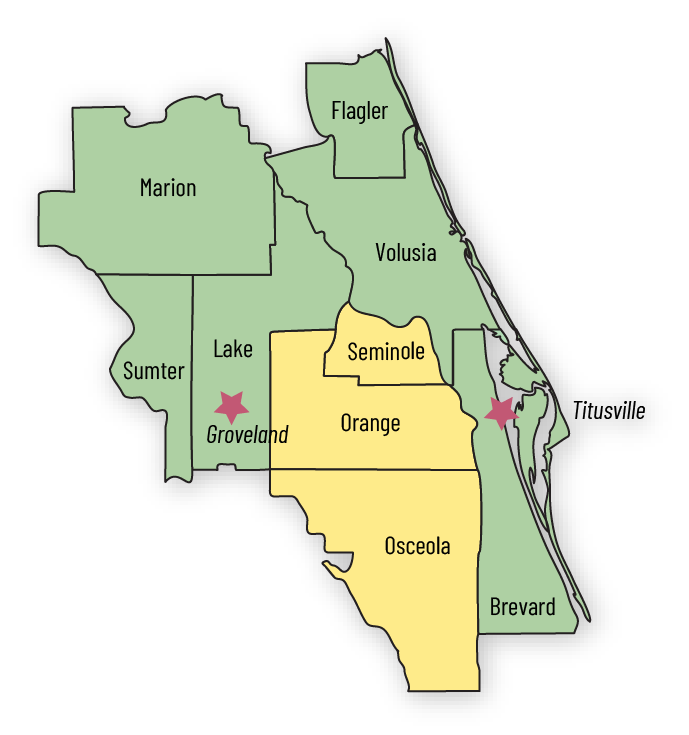
Click on the county name to view contacts and a copy of the resolution.
Vince Lamb partnered with fellow Brevard resident Beth Glover to recruit numerous community organizations to support the resolution. They submitted letters of support from those when they requested the county commission consider the resolution. On Sept. 7, 2010, the county commission voted unanimously to adopt it.
See a copy of the resolution.
Trails advocate Herb Hiller notified Flagler County Commissioner Milissa Holland of the Wildflower Resolution, who passed it to Carl Laundrie, county communications manager, to research. Mr. Laundrie knew that, as one of the counties working on the 260-mile St. Johns River to the Sea Loop multipurpose trail, the resolution’s adoption was a mandatory step in qualifying for Florida Wildflower Foundation funding to plant wildflowers along the trail. The resolution was signed and filed with the Clerk of Court on May 12, 2011 by County Commission Chairman Alan Peterson and was ratified by the County Commission on May 16, 2011.
See a copy of the resolution.
The Resolution Supporting the Conservation of Roadside Native Wildflowers was adopted by Groveland’s City Council on Oct. 3, 2022.
See a copy of the resolution.
After receiving a copy of the model resolution, Lake County’s Green Team asked the Florida Wildflower Foundation to make a presentation to the panel. County staff then reviewed and revised the resolution, which the Green Team submitted to the commission. The resolution was unanimously adopted on June 1, 2010.
See a copy of the resolution.
See a copy of the resolution.
Sumter County has long valued its wildflowers. Many of its roadways have been planted by the Florida Department of Transportation, providing a beautiful display each spring. In 2007, the UF/IFAS Sumter County Extension Office also received a grant from the Florida Wildflower Foundation to plant a Wildflower Demonstration Garden at the West Central Florida Agricultural Education Center in Bushnell. When a county Wildflower Resolution was presented to the Board of County Commissioners on March 27, 2012, the panel voted unanimously to pass it as a sign of its commitment to wildflowers.
See a copy of the resolution.
The Florida Wildflower Foundation asked Commissioner Pat Northey to sponsor the resolution. After county staff reviewed it, the resolution was passed to the county commission. On May 6, 2010, Lisa Roberts made a short presentation to the commission, which then voted unanimously to adopt the resolution.
See a copy of the resolution.
The Florida Wildflower Foundation asked Commissioner Pat Northey to sponsor the resolution. After county staff reviewed it, the resolution was passed to the county commission. On May 6, 2010, Lisa Roberts made a short presentation to the commission, which then voted unanimously to adopt the resolution.
See a copy of the resolution.
District 6
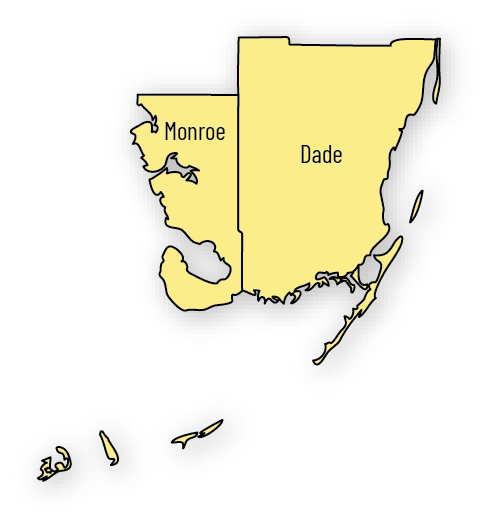
District 6 currently has no Wildflower Resolutions in place.
District 7
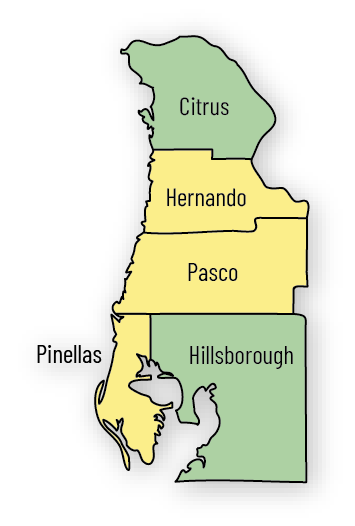
Click on the county name to view contacts and a copy of the resolution.
See a copy of the resolution.
See a copy of the resolution.
District 1
Click on the county or city name below to view contacts and a copy of the resolution.
District 2

Click on the county or city name below to view contacts and a copy of the resolution.
District 3
Click on the county or city name below to view contacts and a copy of the resolution.
District 4
Click on the county or city name below to view contacts and a copy of the resolution.
District 5

Click on the county or city name below to view contacts and a copy of the resolution.
District 6
District 7
Click on the county or city name below to a copy of the resolution.
